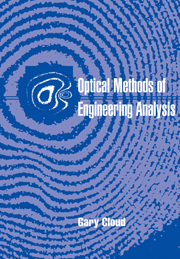Book contents
- Frontmatter
- Contents
- Acknowledgments
- 1 Introduction and orientation
- Part I Optics and interferometry
- Part II Photoelasticity
- Part III Geometrical moire
- Part IV Diffraction theory, optical processing, and moire
- Part V Moire interferometry
- Part VI Holographic interferometry
- Part VII Speckle methods
- 18 Laser speckle and combinations of speckle fields
- 19 Speckle photography
- 20 Speckle correlation interferometry
- 21 Electronic speckle pattern interferometry
- 22 Phase shifting to improve interferometry
- Author index
- Subject index
22 - Phase shifting to improve interferometry
Published online by Cambridge University Press: 12 January 2010
- Frontmatter
- Contents
- Acknowledgments
- 1 Introduction and orientation
- Part I Optics and interferometry
- Part II Photoelasticity
- Part III Geometrical moire
- Part IV Diffraction theory, optical processing, and moire
- Part V Moire interferometry
- Part VI Holographic interferometry
- Part VII Speckle methods
- 18 Laser speckle and combinations of speckle fields
- 19 Speckle photography
- 20 Speckle correlation interferometry
- 21 Electronic speckle pattern interferometry
- 22 Phase shifting to improve interferometry
- Author index
- Subject index
Summary
It seems fitting to close this text by discussing a technique that can be used to improve the precision, convenience, and usefulness of all varieties of interferometry. The basic idea is to insert into one of the optical paths a device that will provide known phase shifts. By doing this a few times, the exact phase at a point in the unknown can be deduced from only intensity measurements at that point. There is no need to map fringes and interpolate between them. The origins of the idea seem to date from the early days of photoelastic interferometry when simple compensators were used to improve measurements of birefringence. The approach has gained popularity with the advent of powerful microcomputers and improved electronic imaging technology. It is especially useful in electronic speckle pattern interferometry, so the idea and examples are presented in that context. Keep in mind that existing and potential applications are much broader in scope.
A perspective
When first getting involved in the use of phase shifting to enhance interferometry, whether electronic speckle or any other variety, it is very easy to become mired in the mathematics and the various computer algorithms that are promoted. One then loses sight of the essential simplicity of the concept, its universality, and its utility. Some background is in order, and then the basic concept will be presented in order to efficiently learn about the phase-shifting approach.
First, let us retrace briefly what we have been doing in collecting and interpreting interferometric fringe data. With few exceptions, one being pointwise birefringence measurements using a compensator or polarization (e.g., Cloud 1968), it is usual that a picture of a fringe pattern is created.
- Type
- Chapter
- Information
- Optical Methods of Engineering Analysis , pp. 477 - 492Publisher: Cambridge University PressPrint publication year: 1995
- 1
- Cited by

